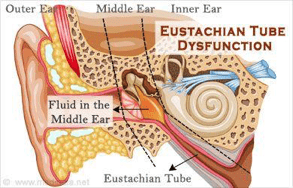Blocked ear and blocked nose problems are often linked to the Eustachian pressure tube which sits at the back of the nose. One end of this pressure tube opens up in the space behind the eardrum while the opposite end opens up in the space at the back of your nose. So a bad flu, severe cold, sinus infection and allergy problems of the nose can all lead to these bothersome symptoms. Rarely, tumours growing at the back of your nose can also cause a blockage of your nose, ears and Eustachian pressure tube.

Here are Singapore ENT Specialist, Dr Annabelle’s 5 tips to help you unblock your blocked nose and blocked ears:
- You can try a course of antihistamine medication such as Telfast or Zyrtec which can help to reduce any soft tissue swelling and mucus backflow inside your nose. By drying up the constant backdrip of mucus at the back of your nose, this can help to open up your Eustachian pressure tubes to relieve the blocked ear sensation, which is annoying you.
- Using a nasal steroid spray such as Avamys or Nasonex may help to relieve any allergic process going on inside your nose, which can help the irritation of your Eustachian pressure tubes and blocked ears. If you cannot get hold of these nasal steroids as many places require a doctor’s prescription, then you can try nasal decongestant sprays such as Otrivine, Afrin or Iliadin. But these nasal decongestants should not be used regularly for too long, no longer than 5-7 days maximum, as they can lead to permanent damage of the soft tissue inside your nose.
- Taking oral decongestants such as phenylephedrine found in Telfast-D, Zyrtec-D or in fact any antihistamine ending in the capital D, can work more quickly to dry up the secretions or mucus inside your nose and reduce soft tissue swelling. This in turn may help relax your congested Eustachian pressure tubes to help your blocked ear sensation. But again, you should not take these oral decongestant medications for too long, no longer than a week.
- Sometimes, undertaking steam inhalation, with a few drops of your favourite essential oils such as eucalyptus oil, may help clear your blocked nasal passages, sinuses and Eustachian pressure tubes, relieving the congestion you feel inside your blocked ears. You can try this easily by putting your head and nose over a tub of steaming hot water with a towel covering your head and breathe deeply in and out a few times.
- Gentle manoeuvres to help your throat/palate muscles “pop” open your Eustachian tubes may work sometimes: Try pinching your nose closed and gently blowing out with both nose and mouth closed at the same time, so that the trapped air is directed into your pressure tubes towards your ears. Swallowing repeatedly or yawning widely can also help open up your Eustachian pressure tubes, just like when you’re trying to “pop” your ears when your flight lands.
If the above measures still don’t help your blocked ears and blocked nose symptoms, then you should see your otolaryngologist to discuss other ways to treat it such as balloon dilation of the Eustachian tube.
The Editorial Team at Healthcare Business Today is made up of skilled healthcare writers and experts, led by our managing editor, Daniel Casciato, who has over 25 years of experience in healthcare writing. Since 1998, we have produced compelling and informative content for numerous publications, establishing ourselves as a trusted resource for health and wellness information. We offer readers access to fresh health, medicine, science, and technology developments and the latest in patient news, emphasizing how these developments affect our lives.







